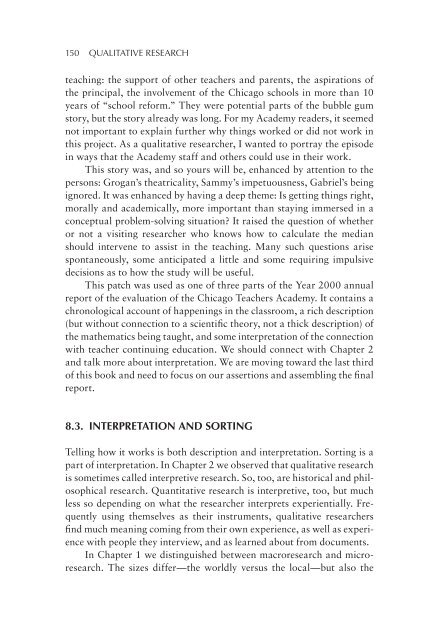How Things Work - Doha Academy of Tertiary Studies
How Things Work - Doha Academy of Tertiary Studies
How Things Work - Doha Academy of Tertiary Studies
You also want an ePaper? Increase the reach of your titles
YUMPU automatically turns print PDFs into web optimized ePapers that Google loves.
150 QUaLItatIVe ReSeaRCH<br />
teaching: the support <strong>of</strong> other teachers and parents, the aspirations <strong>of</strong><br />
the principal, the involvement <strong>of</strong> the Chicago schools in more than 10<br />
years <strong>of</strong> “school reform.” They were potential parts <strong>of</strong> the bubble gum<br />
story, but the story already was long. For my <strong>Academy</strong> readers, it seemed<br />
not important to explain further why things worked or did not work in<br />
this project. As a qualitative researcher, I wanted to portray the episode<br />
in ways that the <strong>Academy</strong> staff and others could use in their work.<br />
This story was, and so yours will be, enhanced by attention to the<br />
persons: Grogan’s theatricality, Sammy’s impetuousness, Gabriel’s being<br />
ignored. It was enhanced by having a deep theme: Is getting things right,<br />
morally and academically, more important than staying immersed in a<br />
conceptual problem- solving situation? It raised the question <strong>of</strong> whether<br />
or not a visiting researcher who knows how to calculate the median<br />
should intervene to assist in the teaching. Many such questions arise<br />
spontaneously, some anticipated a little and some requiring impulsive<br />
decisions as to how the study will be useful.<br />
This patch was used as one <strong>of</strong> three parts <strong>of</strong> the Year 2000 annual<br />
report <strong>of</strong> the evaluation <strong>of</strong> the Chicago Teachers <strong>Academy</strong>. It contains a<br />
chronological account <strong>of</strong> happenings in the classroom, a rich description<br />
(but without connection to a scientific theory, not a thick description) <strong>of</strong><br />
the mathematics being taught, and some interpretation <strong>of</strong> the connection<br />
with teacher continuing education. We should connect with Chapter 2<br />
and talk more about interpretation. We are moving toward the last third<br />
<strong>of</strong> this book and need to focus on our assertions and assembling the final<br />
report.<br />
8.3. iNteRPRetatiON aND sORtiNG<br />
Telling how it works is both description and interpretation. Sorting is a<br />
part <strong>of</strong> interpretation. In Chapter 2 we observed that qualitative research<br />
is sometimes called interpretive research. So, too, are historical and philosophical<br />
research. Quantitative research is interpretive, too, but much<br />
less so depending on what the researcher interprets experientially. Frequently<br />
using themselves as their instruments, qualitative researchers<br />
find much meaning coming from their own experience, as well as experience<br />
with people they interview, and as learned about from documents.<br />
In Chapter 1 we distinguished between macroresearch and microresearch.<br />
The sizes differ—the worldly versus the local—but also the

















